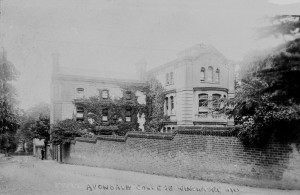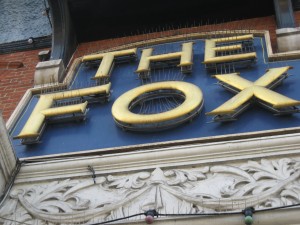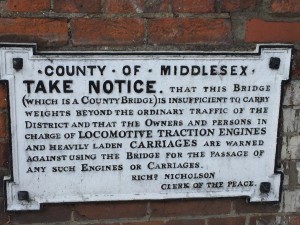Neighbours, the time is almost upon us. Ever since the manuscript was found in the town hall telling of the way in which our forebears banished evil, there has been an imperative to make sure that Palmers Green remains pure and good hearted. With the Palmers Scream this evening, at 5.15 sharp in Broomfield Park, we will meet together and celebrate the dark, and our stories.
Year: 2015

On 8th May 1905 a tiny new school was opened Palmers Green at no 1 Osbourne Road, its founder a passionate 29 year old from Tottenham who had decided from the age of just three that it would be her vocation to be a teacher.
Alice Nellie Hum was a woman with a gift. According to Frances Spalding:
…[she] enjoyed huge respect. She was a small, red-cheeked woman invariably dressed in brown: velvet in winter, silk and cotton in the summer. She was bright, cheerful, energetic and a silent martyr to ill health. Though small in stature and nicknamed ‘Cow’s Eyes’ by her pupils, she exerted complete authority and was capable of making the largest girl feel very small.
We might not know so much about Miss Hum of course had she not had two famous pupils – in fact, arguably the most famous people that Palmers Green ever produced – the writer Stevie Smith, who began attending the school in 1911 when she was 9, and her contemporary the actress Flora Robson, who was 13 when she began there in 1915.
And had she not taught both of them English literature from her front room at 1 Osbourne Road. Said Robson of the lessons, where the girls sat on the floor
Miss Hum had a great gift for imparting her love of literature, it was not just a lesson. My hands shook with joy when I picked up the Golden Treasury of Verse, my Tennyson, and the works of William Shakespeare…it was not just a swallowing of facts and figures; like a pebble dropped into still waters, the circles widened till we began to love what we studied, and went on with our studies after we left school.
Miss Hum was also a woman of principle – when war broke out, she read anti-war poems to her pupils to counteract the jingoistic atmosphere that was prevailing in the area. She was a very wise and original lady said Stevie Smith ‘because when the war came…she said that not absolutely every German was ‘a fiend incarnate’ as was the general opinion in our suburb’.

The school had six pupils on its opening day, but expanded so quickly that it had spilled over into the house on the same corner but fronting Green Lanes 1907, and then into a third building. By 1912 when Miss Hum went into partnership with her cousin Elsie Roberts and friend Esther Tempest, its reputation had apparently grown to the point where families were moving to Palmers Green to be near the school. By 1918 the school had grown to 300 pupils and had moved to Avondale Hall, in Hoppers Road.
Sadly, Palmers legendary teacher did not have a long life. Hum had become a Quaker in 1916, her faith inspiring the school’s motto By love serve one another. She died aged just 53, and is buried at the Quaker Meeting House in Winchmore Hill. Her legacy continues: Palmers Green High School in Hoppers Road.
(Quotes are taken from from Frances Spalding’s Stevie Smith: A biography)
- This article has been prepared as part of the process to nominate buildings and landmarks to Enfield’s updated local list. For more information see http://www.palmersgreenn13.com/2015/09/11/every-street-in-palmers-green/. And if you have any suggestions for buildings which aren’t listed but should be included in the local list, please get in touch. But do get in touch soon, as submissions need to be in by the second weeks in November.
 Why do I love The Fox? Well, I admit to having had a drink in there once or twice, several trips to Talkies, and even been to a christening. It is also, so far, Enfield’s only Asset of Community Value.
Why do I love The Fox? Well, I admit to having had a drink in there once or twice, several trips to Talkies, and even been to a christening. It is also, so far, Enfield’s only Asset of Community Value.
But none of those things are really it. This series is about buildings we think should appear on Enfield’s list of local heritage assets. And The Fox to me fits the bill better than almost any of the buildings that were missed from the last edition.
Why? because in many ways it is the most iconic building in Palmers Green. Coming into Palmers Green from the north, it announces Palmer Green in bold and high Edwardian style, preparing one for the exuberant Sykes architecture further down.
The case for the importance of the Fox was made in the application for The Fox to become an Asset of Community Value earlier this year, so, at the risk of boring through repetition, I will simply allow an edited version of those words to make the case for the Fox also appearing on the List of Local Heritage Assets.
The Fox stands in a prominent position on the corner of Green Lanes and its namesake, Fox Lane. Tall and imposing, for those coming to Palmers Green from the north, it acts as a gateway into Palmers Green’s main shopping area.
The Fox has a number of accolades. It is the oldest remaining pub in Palmers Green to have continuously stood on the same site – there has been a Fox on the site for over 300 years. It is also the only purpose built public house still remaining open on the main route between Wood Green and some way north of Winchmore Hill, the others being shop conversions with little architectural or historical merit.
The current building, of 1904, was built as part and parcel of the Edwardian development of Palmers Green. The size and grandeur of the building is a reminder that Palmers Green was once a place of enough significance to require a hotel and associated dining for travellers. Before the coming of the car, the Fox was the terminus of the horse drawn bus service into London, run by the Davey family of publicans who had stables at the back. Once the trams came, it was a major landmark on the journey from London. All taxi drivers still know the Fox.
As a former bus and train terminus, and a hotel, the Fox has always been at the centre of Palmers Green’s social and community life. June Brown, Dot Cotton from Eastenders, ran her theatre company from it, bands, including big names like Geno Washington and the Ram Jam Band, have played in it, famous comedians perform in it to this day, and the famous have drunk in it – locals like Rod Stewart and Ted Ray and visitors including the famous names who trod the boards at the Intimate Theatre.
The Fox, then, holds a position of huge cultural significance in an area, which tends to think of itself as having a short past… If Palmers Green were ever to lose its landmark pub, and this landmark building, it would lose part of itself.
I still do not know the architect, having tried all the usual places, but perhaps there will be someone reading this who has a cunning ruse to find out, or can even tell me.
Nomination for the local list: The Fox
- This article has been prepared as part of the process to nominate buildings and landmarks to Enfield’s updated local list. For more information see http://www.palmersgreenn13.com/2015/09/11/every-street-in-palmers-green/. And if you have any suggestions for buildings which aren’t listed but should be included in the local list, please get in touch.
We have had several great comments with more information following my post about Deadman’s bridge – thank you Sylvia Gambin and Steve Foster.
And Richard McKeever from the excellent Bowes and Bounds Connected has given us the following information about Richard Nicholson who is mentioned on the Palmers Green sign. He became Clerk of the Peace in 1869 and retired and died in 1913. The bridge itself dates from the 1880s. Here is what Richard says (you can read the full article at http://www.bowesandbounds.org/profiles/blogs/solving-the-puzzle-of-deadman-s-bridge):
“The office of clerk of the peace – like that of his boss, the Justice of the Peace – dates from the Fourteenth Century when they had a criminal law function to investigate “all manner of poisonings, enchantments, forestallings, disturbances and abuses”, by the Sixteenth Century their work extended to include more mundane administrative functions for the county. As the bureaucratic workload of Middlesex County Council grew, particularly during the Eighteenth and Nineteenth Centuries, more officers were appointed for specific tasks, but the offices still retained their medieval names.
Nicholson was born in Hertfordshire in 1828 and educated in Exeter – but he spent some of his early life even further south as a surveyor in New Zealand he was part of the New Zealand Company team that In 1844, sailed on the Deborah, to survey and purchase land from local Maori leaders. Nicholson is credited with laying out the city of Dunedin. On one occasion during his trip to New Zealand’s south Island he found himself in danger as the ship chartered to take him and his colleagues ran into difficulties – Nicholson’s story is recorded in the book “Early contributions to the History of New Zealand” by Thomas Morland Hocken:
Colonel Wakefield prior to his own departure from Wellington had despatched the Carbon, a 20-ton schooner to Otago on the 26th of June, having on board Messrs. Richard Nicholson and Albert Allom, who were surveying cadets, and seven men selected for their knowledge of bush work. The voyage was perilous enough, …. Driven into various bays, their food exhausted, sails split to ribbons, and all but wrecked, the voyagers did not reach their destination for a month after leaving Wellington.
Nicholson survived the journey completed his surveying work and returned to London where he became a solicitor in 1852 and took up the role of Clerk of the Peace in 1869.
In his later life he was embroiled in a minor controversy when the Southgate Recorder questioned his income and expenses – much like our modern day MPs expenses scandal. A stipend to the Clerk of the Peace was used by him to employ his own staff. The local paper celebrated the change to more transparent arrangement where staff became individual employees of Middlesex County Council.
Richard Nicholson was Knighted in 1886, in recognition of his public service he retired and died in 1913 and his obituary was published in the Times as well as newspapers in New Zealand and Australia.”
Deadman’s bridge and the traction engine sign, Green Lanes
If you walk down Green Lanes in the direction of the north circular on the west side of the road you will eventually come to Deadman’s bridge. This stretch of road was once known as Deadman’s Hill, although no one seems to know quite why (unless you credit the fanciful story of Gabriel Haynes and his tragic accident which appears elsewhere on this site).
The name appears to be ancient. A History of the County of Middlesex vol 5 (www/british-history.ac.uk) states that in the sixteenth century Green Lanes was a collection of linked roads, one of them being Deadman’s Hill in Palmers Green. In 1789 they find a reference to “Bowes Farm Bridge, presumably Deadman’s bridge in Green Lanes” where “a single arch, was built…by the road trustees and repaired in 1822 by the county”. It is reasonable to assume that the 1789 bridge replaced an earlier structure, (given that Pymmes Brook always needed to be traversed by those heading north out of London). Presumably too the present bridge is in part or wholly another post 1822 incarnation.
One further curiosity on the bridge is a black on white and well cared for sign which gives warning to traction engines and other heavy vehicles.
‘COUNTY OF MIDDLESEX / TAKE NOTICE that this Bridge / which is a County Bridge is insufficient to carry / weights beyond the ordinary traffic of the / District and that the owners and persons in / charge of LOCOMOTIVE TRACTION ENGINES / and heavily laden CARRIAGES are warned / against using the Bridge for the passage of / any such Engines or Carriages / Richd. Nicholson / Clerk of the Peace.’
 The reference to traction engines dates it to the last part of the 19th century or the beginning of the 20th, though traction engines were a common sight well into the post war years. My personal guess is that this sign is from before the first world war, when the building boom in Palmers Green began in earnest. There must have been a huge weight of traffic as the builders brought in materials from all over London and the south east (though much clay was actually extracted locally).
The reference to traction engines dates it to the last part of the 19th century or the beginning of the 20th, though traction engines were a common sight well into the post war years. My personal guess is that this sign is from before the first world war, when the building boom in Palmers Green began in earnest. There must have been a huge weight of traffic as the builders brought in materials from all over London and the south east (though much clay was actually extracted locally).
I have written to the National Traction Engine Trust, but so far no reply. I will get in touch with Enfield Local Archives to see if they know more about Richard Nicholson.
- This article has been prepared as part of the process to nominate buildings and landmarks to Enfield’s updated local list. For more information see http://www.palmersgreenn13.com/2015/09/11/every-street-in-palmers-green/. And if you have any suggestions for buildings which aren’t listed but should be included in the local list, please get in touch.
Times are tough for cash strapped local authorities as they seek to provide a plethora of essential services. Unsurprising then, that Enfield Council has been looking for areas in which it can find economies. One such appears to be Enfield Local Studies Centre and Museum.
The Enfield Local Studies Centre identifies, acquires, and preserves archival materials that document the history of the London Borough of Enfield, and makes records available for the benefit of all. If you haven’t been there personally, you will have to take my word for it that it’s run by an amazing staff, who have a brilliant knowledge and a genuine enjoyment in revealing the uncovered history of the borough.
The archive probably doesn’t bring in much hard cash directly, but it performs wonders in developing a sense of place in Enfield, working across the generations and helping promote the borough, and helping others to do so. Palmers Green Jewel in the North wouldn’t have anything like its current content without help from the team, in particular in sourcing photos and references.
Until 18 October, Enfield Council is running a consultation on big changes to the archive. The aim is to digitize the entire collection so that it will be available online, but – to avoid a drop in service while that digitization is happening – if the plans go ahead you will only be able to visit by appointment. It will be exciting to be able to access the archive online but once the digitization is complete there is no indication of what might happen to the service and the team, and that is where my concerns for the service really set in in earnest.
A petition has been set up via 38 Degrees – I am not sure that it is quite accurate in that the petitioners seem to think that the intention is to make the digital archive available via Ancestry.co.uk, which is not the case from my reading of the consultation information. Enfield Council has also not explicitly said that the service will be cut, although obviously that is a reasonable fear. You can sign the petition here – more importantly, if you care about the archive, please respond to the consultation by clicking here.
.

